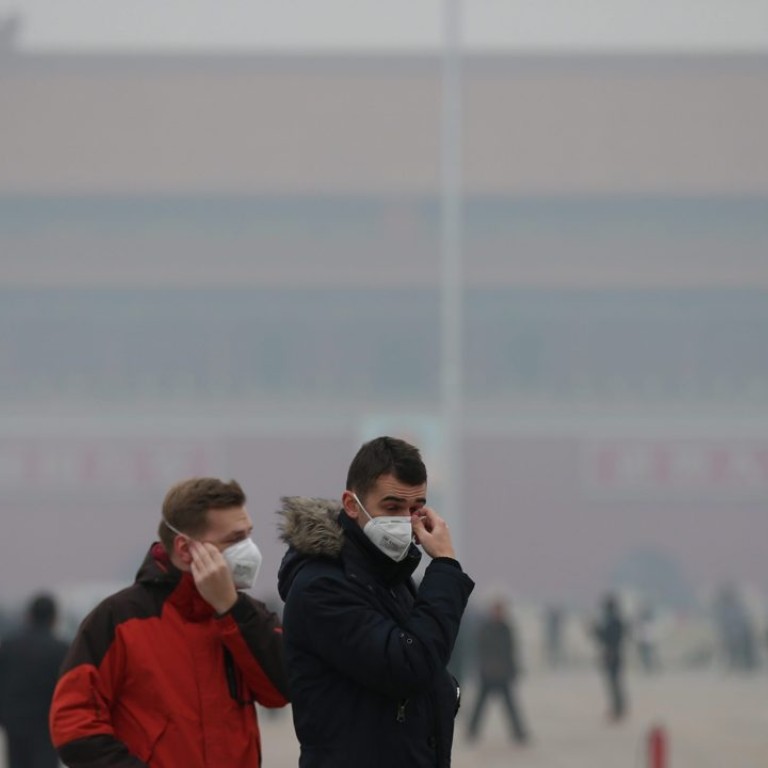
Beijing’s air quality is supposed to be improving ... so why is the city still shrouded in smog?
A promising nine months followed pledges of a crackdown, but pollution is back on the increase and experts are blaming unchecked emissions
Despite widespread public discontent over pollution in Beijing – and a yellow alert for smog yesterday – statistics show air quality actually improved in the first nine months of the year.
But even so, it may be too early celebrate, as levels of PM2.5 pollutants – tiny particles that when inhaled can cause health problems including cancer – rebounded this month and last month.
The results add to concerns that improvements may be short-lived as local governments continue to support heavy-polluting “zombie companies” that are struggling due to over-capacity.
Watch: Time-lapse video of Beijing smog
Data compiled by Greenpeace, based on results from official monitoring stations, showed Beijing’s PM2.5 levels had stabilised and then improved from January to October compared to the same period a year ago.
The trend follows Premier Li Keqiang’s (李克強) declaration last year of a “war on pollution”.
READ MORE - China will use ‘iron fist’ against pollution, Premier Li Keqiang vows
But the Greenpeace data also showed PM2.5 levels surging in November – a trend echoed in data collected by the US embassy.
Average levels of PM2.5 dropped 16.6 per cent in the first 11 months of this year, according to Beijing municipal development and reform commission.
Data for December is not complete, yet Beijing has had only five days this month when the city’s Air Quality Index was below 100, rating “good”. This month municipal authorities have issued two red alerts for smog, two orange, and two yellow.
Neighbouring Tianjin (天津) is expected to experience 6.5 days of smog this week.
Yesterday, a yellow alert for smog had many Beijingers questioning why the problem was getting worse despite a slowing economy and government pledges to crackdown on polluters.
Winter months are usually the most polluted in northern China, due to the increased use of central heating in downtown areas and the burning of low-quality coal by households in suburban areas.
Some experts say burning of coal in small-scale stoves is a greater cause of pollution than large thermal power plants due to inefficiency and high levels of sulphur and ash in coal.
Watch: Beijing cloaked in smog as schools, factories close
Government departments blame the smog on a variety of causes, such as illegal pollution discharges at factories, vehicle emissions, high-level coal consumption and burning of corn stalks. They also blame weather factors such as slower winds, humidity and a lack of cold fronts.
The national climate centre said the average wind speed in areas surrounding Beijing this winter – at 1.8 m/second – was about 10 per cent lower than the annual average.
But some analysts said unchecked emissions from heavy polluting sectors were to blame, despite the central authorities’ vow to reform the industry.
READ MORE - China makes no new promises in battle to clear the day as it fine-tunes pollution targets
Frank Tang, an economist with North Square Blue Oak Ltd (NSBO), an investment bank based in London, said data showed Hebei’s (河北) crude steel production surged 15.7 per cent year on year in November, the highest jump since 2012, amid a 2.2-per cent nationwide drop and shrinking demand in general.
“This is to make up for the output reduction in previous months, such as in preparation for ‘parade blue’,” said Tang, referring to the blue skies that followed pollution reduction measures ahead of a military parade this year. He said many state-owned steel producers would get subsidies from local authorities who did not want to see them go bankrupt.
Beijing and northern Chinese cities adopted large-scale temporary pollution reduction measures in the run up to an APEC meeting in November 2014, and a military parade in September this year.
Watch: Heavy smog in China as index reaches highest levels
Measures included suspending factory production, halting construction and restricting car usage.
Tian Miao, an analyst with NSBO, said many central heating companies in Hebei were burning coal again due to a drop in price, even though they were supposed to have switched to cleaner natural gas.
Natural gas accounted for about 4.9 per cent of energy use in the first nine months despite a national goal of 9 per cent this year.
“Also there is no authoritative supervision on fuel quality at gas stations. The three state-owned oil giants do not have incentives to upgrade fuel quality due to shrinking profits,” said Tian.
Dong Liansai, a campaigner with Greenpeace, said the trend showed short-term fixes would not solve the smog problem.


